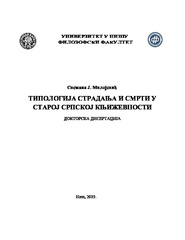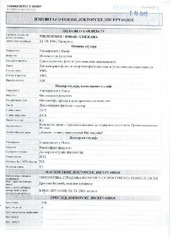Приказ основних података о дисертацији
Tipologija stradanja i smrti u staroj srpskoj književnosti
| dc.contributor.advisor | Bojović, Dragiša | |
| dc.contributor.other | Špadijer, Irena | |
| dc.contributor.other | Kostić Tmušić, Aleksandra | |
| dc.creator | Milojević, Snežana J. | |
| dc.date.accessioned | 2020-10-12T09:09:39Z | |
| dc.date.available | 2020-10-12T09:09:39Z | |
| dc.date.issued | 2020-06-04 | |
| dc.identifier.uri | http://eteze.ni.ac.rs/application/showtheses?thesesId=7534 | |
| dc.identifier.uri | https://fedorani.ni.ac.rs/fedora/get/o:1662/bdef:Content/download | |
| dc.identifier.uri | http://vbs.rs/scripts/cobiss?command=DISPLAY&base=70052&RID=16843017 | |
| dc.identifier.uri | https://nardus.mpn.gov.rs/handle/123456789/17495 | |
| dc.description | The aim of this PhD thesis is the typological classification of the dominant models describing suffering and death in Old Serbian Literature. Since the written expression of the Middle Ages was based on Christianity, the phenomena which are the subject of our research are studied through Christian ontology. We particularly focused on the Holy Scripture and written documents of saints as the methodological framework of the analytical approach. Judging from the inter-textual communication between arch-texts and the texts which are the topic of our research, we conclude that the motif of suffering in the Medieval text was based on the premise of the incompatibility of man’s and God’s wills, as well as stating that the cause of an individual’s suffering could be found only in his sinful personality represents a superficial view on Christian cosmogony. Suffering is not imminent only to those who are the embodiment of evil in the human form but also to those whose life was dedicated to essential values: an individual’s life through suffering from the first to the last moment was considered as God’s interest in the individual’s salvation. All heroes of life scriptures went through different forms of suffering – family conflicts, illnesses, invasions of enemies, invasion of demons – as kinds of temptation, which in the literature of the period was presented as a kind of instability to fight through the invention of the sickened individual and God’s grace. That is the reason why in this research we also studied in greater detail the phenomena which were an inseparable part of the PhD, Dragiša Bojović, full professor, University of Niš, Faculty of Philosophy, descriptions of suffering and death in Old Serbian Literature, such as: dreams and visions, God’s miracles and the metaphysical presence of angels. The study researches also some forms of the ascetic process of the individual, which sublimates his spirit and makes him closes to his goal – an eternal life in Christ. The basic idea for establishing a typology of death in Old Serbian Literature is founded on the Christian belief that there are three kinds of death, namely: spiritual, bodily and cosmic or eternal suffering. Man’s spirit dies through evil in it – described through hijacking, racketeering, cunningness, pride of conquerors and rules; will for power, brotherly envy, temptation of heresy. The dedication of the heroes to good or evil in its final destination (in the category of eternity) basically comes to a dichotomy: an eternal life (of the righteous and pious man) or eternal death (of the people subjected to the devil). The insistence on the thought of Christ as a founded medieval written expression and the results of such an approach to this topic bring certain movement in the reception of the Old Serbian Literature, most frequently interpreted from the ethnological, anthropological or ideological point of view. This movement, motivated by the methodological context, includes the removal of the Cartesian focus of rationalizing these phenomena because the idea of suffering and death in the cosmogony of the medieval man (and consequently the medieval hagiographer) was absolutely different from the modern experience of these life constants. Not only is it different but it is also relativized – suffering can be the result of the conflict with God’s will, but also an expression of God’s love to the individual, while the dichotomy life-death has a modified meaning: neither are the living so much alive as it seems nor are the dead as much dead as it seems. | en |
| dc.format | application/pdf | |
| dc.language | sr | |
| dc.publisher | Универзитет у Нишу, Филозофски факултет | sr |
| dc.rights | openAccess | en |
| dc.rights.uri | https://creativecommons.org/licenses/by-nc-nd/4.0/ | |
| dc.source | Универзитет у Нишу | sr |
| dc.subject | Stara srpska književnost | sr |
| dc.subject | Old Serbian Literature | en |
| dc.subject | interetekstualnost | sr |
| dc.subject | Sveto pismo | sr |
| dc.subject | tipologija | sr |
| dc.subject | hrišćansko učenje | sr |
| dc.subject | stradanje | sr |
| dc.subject | smrt | sr |
| dc.subject | Holy Scripture | en |
| dc.subject | intertextuality | en |
| dc.subject | typology | en |
| dc.subject | Christian thought | en |
| dc.subject | suffering | en |
| dc.subject | death | en |
| dc.title | Tipologija stradanja i smrti u staroj srpskoj književnosti | sr |
| dc.type | doctoralThesis | en |
| dc.rights.license | BY-NC-ND | |
| dc.identifier.fulltext | https://nardus.mpn.gov.rs/bitstream/id/65893/Disertacija.pdf | |
| dc.identifier.fulltext | https://nardus.mpn.gov.rs/bitstream/id/65894/Milojevic_Snezana_J.pdf | |
| dc.identifier.rcub | https://hdl.handle.net/21.15107/rcub_nardus_17495 |



